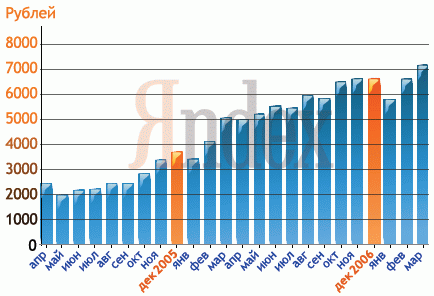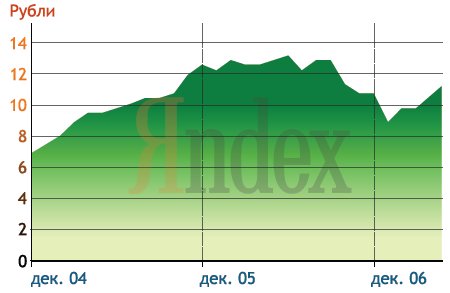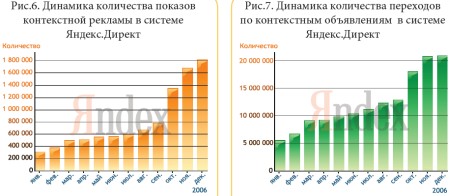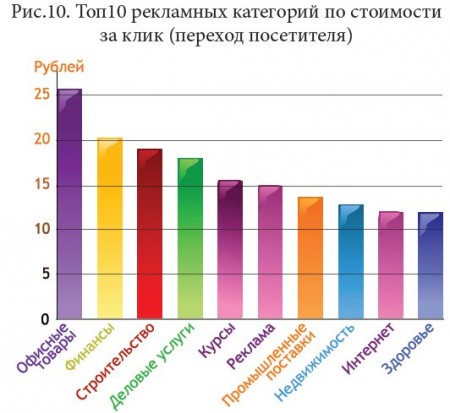Average advertising budget in Russia - 7000 rubles per month
Yandex has released the newsletter Contextual Advertising in Russia. Summer 2007 ”( PDF ). The study was compiled on the basis of Yandex.Direct, the data cover the period from January 2006 to June 2007.
The report for the first time published data on the average budget of advertising campaigns on Yandex.Direct, as well as analyzed the reasons for the decline in the average price of a click.
Contextual Internet advertising is the most dynamic segment of the Russian advertising market today. The growth rate of its volumes in monetary terms is 150–200% per year, which is several times higher than the rate of sales of advertising in traditional media (no more than 30–36% of growth in 2006, according to AKAR). Both in terms of development rates and absolute sales figures ($ 110 million only in 2006), contextual advertising in RuNet is ahead of banner (+ 60% in 2006).

')
The contextual advertising market is becoming increasingly popular. As of June
2007, in the “Direct” system alone, on weekdays contextual ads are shown 140 million times and more than 1.2–1.3 million users navigate to advertisers' sites. From January to December 2006, 147 million user transitions to advertiser sites were registered in the Direct system. In general, in 2006 the monthly traffic to Russian Internet sites, generated by contextual ads, grew almost fourfold. In 2006, more than 30 thousand advertisers underwent advertising campaigns at Direct.
Along the way, with the expansion of the market and the increase in its coverage, the budgets of advertisers for contextual advertising are also increasing. Both in 2005 and 2006, the monthly budget released by the average advertiser to its contextual company almost doubled during the year, so that in March 2007 it exceeded 7,000 rubles.

A good illustration of the change in demand and the corresponding change in supply is the dynamics of the average rate per click. Throughout 2005, it steadily grew (+ 65% by the end of the year), but in 2006 the growth rate stopped. This was largely due to the fact that a large number of advertisers could no longer increase the bid: their business simply did not allow paying even more for each site visitor.

To attract new customers, who have a tightly fixed and small amount of the rate, Direct at the end of 2006 reduced the minimum rate from 3 rubles to 30 kopecks. As a result, the advertiser’s average bid for switching one user dropped significantly, but the number of advertisers and advertising campaigns began to grow. This, in turn, caused the growth of contextual advertising turnovers against the background of a decrease in the average rate. However, in a few months the growth of the average rate was resumed, as well as competition among the newly arrived began to intensify.
As of April 2007, the average conversion rate was about 10% higher compared to the same period in 2005. Thus, a change in the average rate stimulated market expansion; opened it to advertisers from regions and low-margin business segments. At the same time, in high-margin and highly competitive segments (such as, for example, the plastic window market), the average rate per visitor was and remained high.
The marked decrease in the average rate for the transition cannot be considered a trend common to the entire Russian contextual advertising market: the reduction in the minimum rates per click was made only by Direct, while Begun left them at the same level. The monetary growth of the Russian contextual advertising market is not only due to price competition between advertisers (although its influence is indisputable), but also due to the arrival of new advertisers (including from low-margin businesses), an increase in investment in contextual advertising and an overall growth of advertising audience. The ongoing popularization of contextual advertising, that is, the qualitative expansion of its client base, is today one of the most important trends in the development of the advertising market.
As the contextual advertising market develops and its placement conditions change, the behavior of advertisers changes. The most interesting trend in this area is the expansion of the set of keywords for which an ad is displayed. In 2006, the share of redeemed requests in the total number of all requests from search users has almost doubled. This growth was also influenced by the ability to set low rates.

The overall growth in contextual advertising hits in 2006 was 475%; The number of clicks on contextual ads to the sites of advertisers at the same time increased by 280%. The last figure means that the traffic of interested visitors, which provides contextual advertising, for the year increased almost fourfold.
Dynamics of market indicators of previous years is maintained in the current year. During the first quarter of 2007, the average monthly budget of one contextual campaign grew by another 10% (more than one and a half times the average monthly budget of the same period of 2006), the number of advertisers and the number of advertising campaigns also increased by 10%.

Today, the Russian contextual advertising market is actually divided between the two largest players: Yandex.Direct and Runner. According to available data, in monetary terms, Yandex.Direct owns 55-60% of the Russian contextual advertising market, while Begun accounts for 30-35%. The remaining market share is shared by Rorer, Google AdWords, Link.ru, Optimist, and a number of other contextual networks.

Who buys contextual advertising? The largest budgets for contextual advertising in Russia are ready to spend, mainly, businesses with a high cost of attracting customers: participants in the construction and automotive markets, as well as manufacturers and suppliers of industrial goods (B2B segment). Sellers of household appliances and electronics, representatives of financial and insurance businesses, the business services sector, the tourism market and the real estate market provide a significant share of the turnover of the contextual advertising market.

Almost all of these industries are included in the top ten industries, whose representatives are willing to pay the highest price per click.

Some of the industries included in the Top10 on deposits in the turnover of contextual advertising, in the Top10 at the rate per click do not fall. In particular, the sellers of household appliances, travel services and cars, although they spend on contextual advertising significant budgets, set low prices for the transition: the average cost of a visitor in these industries is 8.5, 7 and 5.5 rubles, respectively .
The main share of budgets for contextual advertising accounts for customers from Moscow. The capital provides 70.92% of advertising turnover, while all other regions of Russia - only 25.78% (the rest is the CIS, and two-thirds is Ukraine). For comparison, in the daily search audience "Yandex" Muscovites accounted for only 38% of visitors.
Moscow advertisers are ready to pay a significantly higher price for the attention of the audience - the average cost per click in Moscow and the regions differs by a factor of 2-2.5.

The report for the first time published data on the average budget of advertising campaigns on Yandex.Direct, as well as analyzed the reasons for the decline in the average price of a click.
Contextual Internet advertising is the most dynamic segment of the Russian advertising market today. The growth rate of its volumes in monetary terms is 150–200% per year, which is several times higher than the rate of sales of advertising in traditional media (no more than 30–36% of growth in 2006, according to AKAR). Both in terms of development rates and absolute sales figures ($ 110 million only in 2006), contextual advertising in RuNet is ahead of banner (+ 60% in 2006).

')
The contextual advertising market is becoming increasingly popular. As of June
2007, in the “Direct” system alone, on weekdays contextual ads are shown 140 million times and more than 1.2–1.3 million users navigate to advertisers' sites. From January to December 2006, 147 million user transitions to advertiser sites were registered in the Direct system. In general, in 2006 the monthly traffic to Russian Internet sites, generated by contextual ads, grew almost fourfold. In 2006, more than 30 thousand advertisers underwent advertising campaigns at Direct.
Along the way, with the expansion of the market and the increase in its coverage, the budgets of advertisers for contextual advertising are also increasing. Both in 2005 and 2006, the monthly budget released by the average advertiser to its contextual company almost doubled during the year, so that in March 2007 it exceeded 7,000 rubles.

A good illustration of the change in demand and the corresponding change in supply is the dynamics of the average rate per click. Throughout 2005, it steadily grew (+ 65% by the end of the year), but in 2006 the growth rate stopped. This was largely due to the fact that a large number of advertisers could no longer increase the bid: their business simply did not allow paying even more for each site visitor.

To attract new customers, who have a tightly fixed and small amount of the rate, Direct at the end of 2006 reduced the minimum rate from 3 rubles to 30 kopecks. As a result, the advertiser’s average bid for switching one user dropped significantly, but the number of advertisers and advertising campaigns began to grow. This, in turn, caused the growth of contextual advertising turnovers against the background of a decrease in the average rate. However, in a few months the growth of the average rate was resumed, as well as competition among the newly arrived began to intensify.
As of April 2007, the average conversion rate was about 10% higher compared to the same period in 2005. Thus, a change in the average rate stimulated market expansion; opened it to advertisers from regions and low-margin business segments. At the same time, in high-margin and highly competitive segments (such as, for example, the plastic window market), the average rate per visitor was and remained high.
The marked decrease in the average rate for the transition cannot be considered a trend common to the entire Russian contextual advertising market: the reduction in the minimum rates per click was made only by Direct, while Begun left them at the same level. The monetary growth of the Russian contextual advertising market is not only due to price competition between advertisers (although its influence is indisputable), but also due to the arrival of new advertisers (including from low-margin businesses), an increase in investment in contextual advertising and an overall growth of advertising audience. The ongoing popularization of contextual advertising, that is, the qualitative expansion of its client base, is today one of the most important trends in the development of the advertising market.
As the contextual advertising market develops and its placement conditions change, the behavior of advertisers changes. The most interesting trend in this area is the expansion of the set of keywords for which an ad is displayed. In 2006, the share of redeemed requests in the total number of all requests from search users has almost doubled. This growth was also influenced by the ability to set low rates.

The overall growth in contextual advertising hits in 2006 was 475%; The number of clicks on contextual ads to the sites of advertisers at the same time increased by 280%. The last figure means that the traffic of interested visitors, which provides contextual advertising, for the year increased almost fourfold.
Dynamics of market indicators of previous years is maintained in the current year. During the first quarter of 2007, the average monthly budget of one contextual campaign grew by another 10% (more than one and a half times the average monthly budget of the same period of 2006), the number of advertisers and the number of advertising campaigns also increased by 10%.

Today, the Russian contextual advertising market is actually divided between the two largest players: Yandex.Direct and Runner. According to available data, in monetary terms, Yandex.Direct owns 55-60% of the Russian contextual advertising market, while Begun accounts for 30-35%. The remaining market share is shared by Rorer, Google AdWords, Link.ru, Optimist, and a number of other contextual networks.

Who buys contextual advertising? The largest budgets for contextual advertising in Russia are ready to spend, mainly, businesses with a high cost of attracting customers: participants in the construction and automotive markets, as well as manufacturers and suppliers of industrial goods (B2B segment). Sellers of household appliances and electronics, representatives of financial and insurance businesses, the business services sector, the tourism market and the real estate market provide a significant share of the turnover of the contextual advertising market.

Almost all of these industries are included in the top ten industries, whose representatives are willing to pay the highest price per click.

Some of the industries included in the Top10 on deposits in the turnover of contextual advertising, in the Top10 at the rate per click do not fall. In particular, the sellers of household appliances, travel services and cars, although they spend on contextual advertising significant budgets, set low prices for the transition: the average cost of a visitor in these industries is 8.5, 7 and 5.5 rubles, respectively .
The main share of budgets for contextual advertising accounts for customers from Moscow. The capital provides 70.92% of advertising turnover, while all other regions of Russia - only 25.78% (the rest is the CIS, and two-thirds is Ukraine). For comparison, in the daily search audience "Yandex" Muscovites accounted for only 38% of visitors.
Moscow advertisers are ready to pay a significantly higher price for the attention of the audience - the average cost per click in Moscow and the regions differs by a factor of 2-2.5.

Source: https://habr.com/ru/post/11826/
All Articles